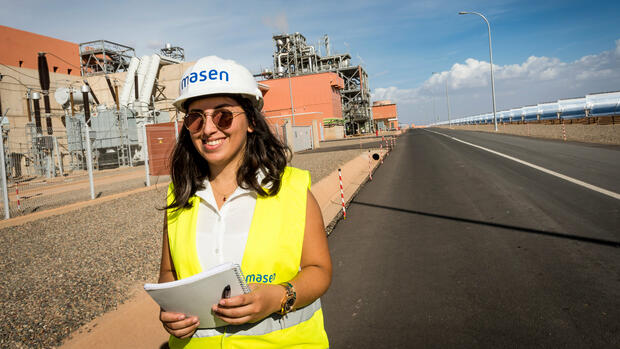Berlin In the coming years and decades, Europe will only be able to partially cover its hydrogen requirements from its own production. For countries like Morocco, Tunisia or Algeria, this opens up great opportunities. But the Europeans must work to build a pipeline infrastructure from North Africa to Europe – to the benefit of both sides. This is one of the central results of an as yet unpublished Deloitte study that is available to the Handelsblatt.
According to Bernhard Lorentz, global head of climate and sustainability at Deloitte, a hydrogen pipeline from North Africa to Europe would be a game changer. The infrastructure would give the development of a hydrogen value chain an enormous boost, he told the Handelsblatt. “Such a lighthouse project would have enormous appeal, it would be in the greatest interest of Germany and also the EU. The geostrategic signal that would emanate from this cannot be overestimated,” added Lorentz. “My impression is that the federal government has recognized that.”
In fact, there are various plans for building such an infrastructure. On the one hand there are gas pipelines that run from North Africa to Spain and France. These pipelines could be converted to transport hydrogen.
Transitional phases in which hydrogen is added to the natural gas are also conceivable. In addition, a consortium led by the Italian pipeline operator Snam announced in the spring that it wanted to build the “South H2 Corridor” hydrogen pipeline. It is to run from Tunisia and Algeria to Bavaria. However, no final investment decision has been made yet.
The supply of green hydrogen is essential for German industry. Industries such as steel, chemicals and cement rely on carbon-neutral hydrogen to make their processes carbon-neutral and to replace oil or coal. Green hydrogen is also needed for heavy goods and air traffic.
Industry will account for 42 percent of hydrogen demand
According to the consensus of many experts, the demand for green hydrogen will increase sharply in the coming years. According to calculations by Deloitte experts, industry will account for 42 percent of demand by 2050 and transport for 36 percent.
The federal government calculates that only 30 percent of the German hydrogen requirement can be covered from domestic production because the possibilities for electricity production from renewable sources are limited in this country.
Sunny and windy regions of the world therefore have good chances of earning money by building up hydrogen production. Electricity from renewable sources is required to produce green hydrogen. The electricity is used to operate electrolysers, in which water is broken down into its components, hydrogen and oxygen.
The federal government is working on establishing supply relationships with potential suppliers of green hydrogen. The decisive vehicle for this is the “H2 Global” foundation, which the federal government has endowed with 4.4 billion euros. On the one hand, this concludes long-term purchase agreements abroad in order to give hydrogen producers planning and investment security.
>> Also read: Germany could obtain hydrogen from these countries in the future
On the other hand, “H2 Global” also agrees sales contracts to meet the need for green hydrogen. This is bought at the lowest possible price and then sold to the buyer who pays the highest price. If, as currently expected, there is a loss at least in the first few years, the foundation should compensate for it from the funds of the Ministry of Economics.
This is how much is to be invested in the hydrogen value chain
The model is considered groundbreaking. According to a study presented on Tuesday, “H2 Global” has the potential to assume a leading role for the entire market development, in which the economics Veronika Grimm and the hydrogen expert Michael Sterner played a leading role.
According to Deloitte calculations, in order to achieve the goal of climate neutrality by 2050, around 9.4 trillion dollars will have to be invested in the hydrogen supply chain by 2050, 3.1 trillion dollars of which will be in developing countries. On average, that’s around $375 billion a year.
In order to be able to achieve the goal of climate neutrality by 2050, around 9.4 trillion dollars must be invested in the hydrogen supply chain by 2050, according to Deloitte calculations.
(Photo: IMAGO/Cord)
The sum sounds gigantic, but the amount is less than the annual global expenditure on oil and gas production, which amounted to around 417 billion dollars in 2022.
>> Read here: Chile is risking its future as a green hydrogen supplier
Lorentz expects positive effects for the countries of the Global South, especially on the labor market: “Green hydrogen will develop into a job machine for developing and emerging countries,” he says.
At the same time, production costs are likely to fall rapidly in the coming years. The cost degression will progress quickly, so the costs decrease the more is produced. “At best, this is comparable to the cost degression that we have seen with photovoltaic modules.”
Industrialized countries are also becoming relevant exporters
But not only developing and emerging countries benefit. Deloitte assumes that four regions will account for a total of 46 percent of global hydrogen production by 2050: North Africa, Australia, North America and the Middle East. European industrial companies have already concluded initial supply agreements with the Australian company Fortescue in recent months.
Deliveries could take place in the middle of the decade at the earliest. The plans in the Middle East are also ambitious. Saudi Arabia stands out in particular. The country is investing massively in the development of hydrogen production.
According to the Deloitte study, Europe, Japan, Korea and India, which account for more than 80 percent of world trade, will develop into the most important import centers.
More: Italy wants to bring green hydrogen from Africa to Germany
